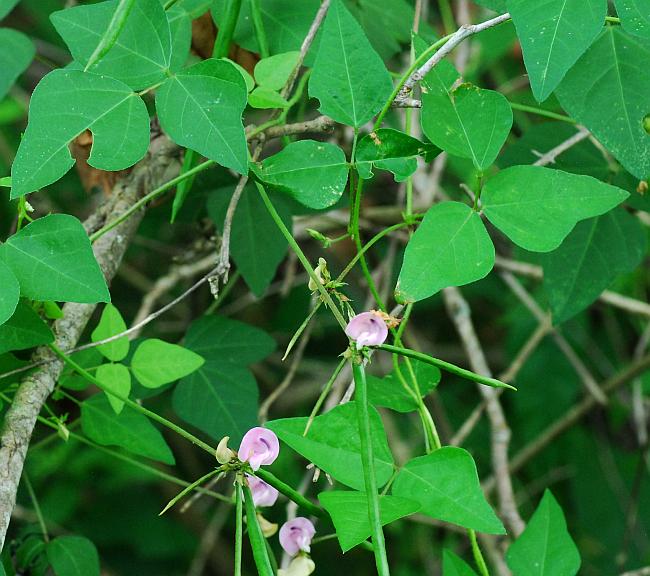Strophostyles helvola (L.) Elliott
Wild Bean

Native
CC = 2
CW = 0
MOC = 75
© SRTurner
Strophostyles helvola (L.) ElliottWild Bean | |
 |
Native CC = 2 CW = 0 MOC = 75 |
© SRTurner |
|
Family - Fabaceae/Faboideae Habit - Taprooted forb, usually annual, twining in other vegetation. Stem - Trailing or climbing, to 3 m, branched, sometimes rooting at nodes, moderately to densely pubescent.
Leaves - Alternate, pinnately trifoliate, petiolate, stipulate. Leaflets rounded or angled at the base, angled or tapered to a bluntly or sharply pointed tip, often with a minute extension of the midvein at the very tip, the upper surface glabrous or sparsely appressed-hairy, the undersurface sparsely to moderately appressed-hairy; the terminal leaflet with a stalk 6-15 mm long, the blades up to 6.5 cm long and 5 cm wide, variously ovate-triangular, oblong-triangular or pear-shaped, asymmetrically ovate, or rhombic, unlobed or with 1 or more commonly a pair of blunt basal lobes.
Inflorescences - Headlike clusters of 3-5 flowers, the inflorescence stalk 5-20 cm long, the flower stalks 1-2 mm long, the pair of bractlets closely subtending each flower 3.0-4.5 mm long, as long as or longer than the calyx tube.
Flowers - Calyces with the tube bell-shaped, 1.5-3.0 mm long, sparsely hairy, the lobes 1.5-3.0 mm long. Corollas papilionaceous, pinkish purple to pink, fading to greenish yellow, the banner 6.5-12.0 mm long, the wings 7-9 mm long, the keel 8-12 mm long and abruptly constricted above the midpoint into a beaklike tip, this relatively slender and usually sharply curved or twisted to the side.
Fruits - Legumes, linear, terete, sessile, 3-9 cm long, 4-10 mm wide, sparsely hairy to nearly glabrous at maturity, 4-10 seeded. Seeds 5-8 mm long, rectangular in outline, the surface sometimes appearing waxy, brown, sometimes faintly mottled, pubescent with white-woolly patches.
Flowering - June - October. Habitat - Forests, streambanks, pond margins, prairies, savannas, glade margins, pastures, open disturbed areas. Origin - Native to the U.S. Lookalikes - Strophostyles leiosperma, S. umbellata. Vegetatively similar to Amphicarpaea bracteata. Other info. - This twining plant is found throughout Missouri, and across the eastern half of the continental U.S. It occupies a variety of habitats which are somewhat difficult to characterize, though perhaps most commonly found along rivers. Photographs taken at Shaw Nature Reserve, Franklin County, MO, 8-26-2006, 9-10-2015, and 9-12-2018, in Pacific, St. Louis County, MO, 7-27-2015, Route 66 State Park, St. Louis County, MO, 9-3-2019, and near Creve Coeur Lake Park, St. Louis County, MO, 8-30-2021 (SRTurner). |